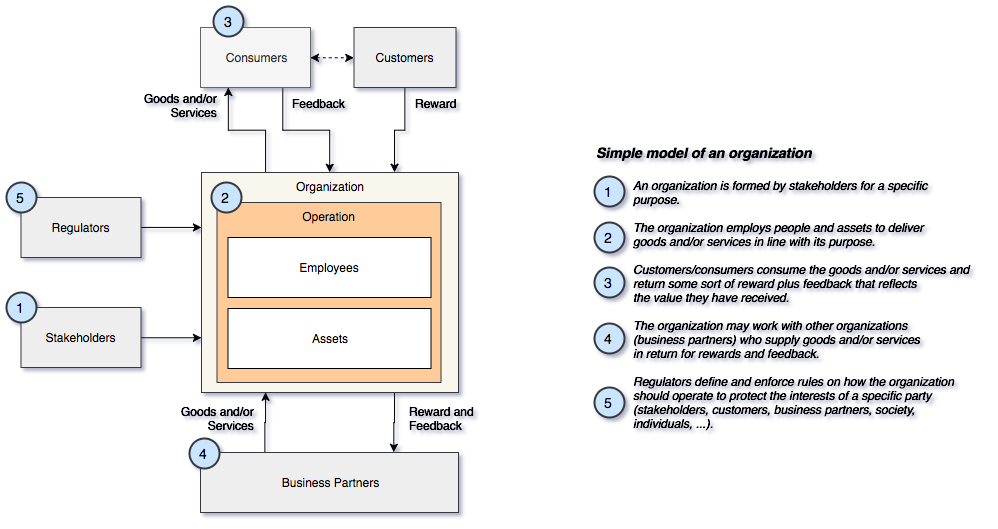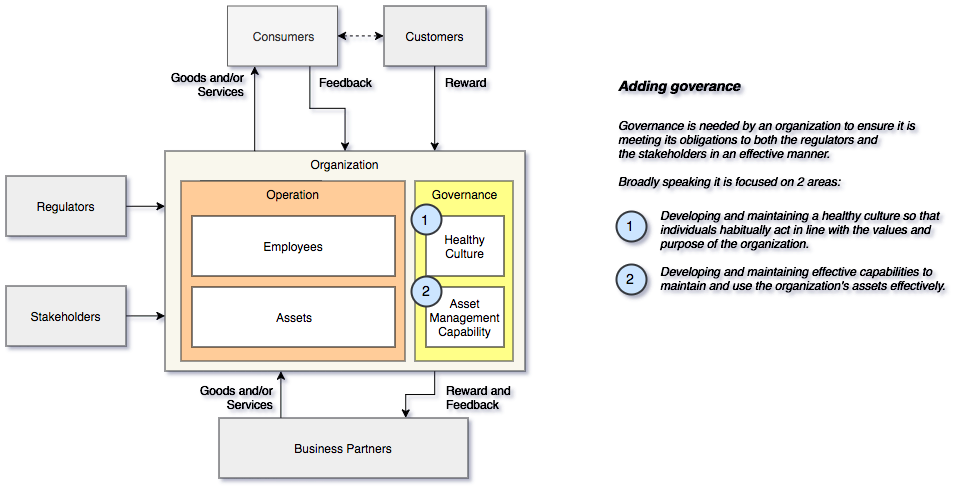Guidance on Governance Introduction
Governance enables all types of organizations (multi-nationals, small businesses, government services, non-profits …) to operate effectively and ethically.
It delivers management system that focuses on the culture of the organization and the way it develops, maintains and uses assets.
Both of these aspects are of extreme importance to modern organizations because:
- Natural resources need to be used in an efficient and sustainable manner.
- Digital services operate at a scale beyond an individuals ability to understand, monitor and control. The technology is moving rapidly and the complexity of modern systems means that the people operating them need specific automated help to ensure they are secure and operating correctly.
- Regulation is imposing exacting requirements on traceability of the organization’s activity.
- Social changes are creating expectations that people are treated with respect and as individuals. The organization must embrace the diversity of the people that interact with it, and treat them fairly.
Good governance creates transparency in an organization’s operation and enables people to develop and be the best they can.
Although each organization is different, there are many common aspects to the way they work (largely because they are built and operated by people) that can act as the framework to this collection of guidance on developing a governance capability.
Consider figure 1:

Figure 1: simple model of an organization
This simple model highlights the key drivers of any type of organization.
Consider the organization’s stakeholders. For a commercial organization, they are the investors. For a department within an organization, they could be the management committee that created the department. For a charity, they are the founders of the organization.
Whoever the stakeholders are, they define a purpose for the organization (eg making a profit selling fish, supporting an organization’s IT systems or feeding starving people after a disaster.) Obviously the purpose can evolve over time, but basically the organization is considered successful if it is meeting its purpose.
For the organization to get started, it needs investment. This typically comes from the stakeholders. They are therefore keen to see that they are getting good value for the investment they provide. That is, they want to see that the organization is cost-effective.
The organization can spend the stakeholder’s investment on:
- People to work on meeting the purpose (employees),
- Assets to support their work (see Note),
- Paying a business partner to perform some of the work that is needed.
Note: The use of the term “Asset” in this model is intended to cover a very broad definition. Examples of assets include buildings, computers, software packages, IT systems, processes, data stores, analytical models, digital locations, intellectual property.
An organization can generate income from providing goods and/or services in exchange for some sort of feedback and reward (payment). These goods and/or services typically involve the organization creating more assets using its employees, existing assets and business partners.
In most cases the recipient of the goods and/or services is the one providing the feedback and reward. However, consider a charity. It supplies support to its target audience (consumers), and receives donations from other sources (customers). Also consider a service that is funded by advertising. The customers are the advertisers rather than the consumers of the service.
Typically, the purpose of the organization includes an aspect of how well it supports its consumers and customers. So the reward often provides the ability to hire more employees and create more assets. The feedback helps them hone the goods and/or services that they offer.
The organization aims to operate in a sustainable manner, using the rewards it receives from is customers to pay for its operation and, potentially provide rewards to its stakeholders (assuming that is part of its purpose).
Finally the regulators protect the interests of particular groups that the organization’s activities may impact. An organization is often working with many types of regulators from the governments and tax authorities of the territories where they a operating, industry regulators ensuring fair competition, financial regulators protecting investors, privacy regulators and safely regulators protecting individuals, as some of the examples.
Governance has evolved as a series of practices and mechanisms within an organization to ensure successful and cost-effective operation that stakeholders and regulators can verify.
Figure 2 shows governance added to the simple organization model.

Figure 2: simple model of an organization with governance
Governance covers both the employees and the organization’s assets. Often the governance of different types of assets and employees is coordinated by different teams. For example:
- Data assets are governed by the data governance team
- Financial assets are governed by the finance team
- Privacy is governed by the privacy team
- Security is governed by the security compliance team
However, their work is inter-related and follows a common pattern. See Governing Systems for more information.
Further reading
- The governance of data
- Delivering governance through the governing systems
- Governance maturity model
License: CC BY 4.0, Copyright Contributors to the ODPi Egeria project.
